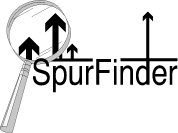SpurFinder enables designers to evaluate various frequency conversion schemes before implementing them. The user simply enters an input frequency range, an output frequency range, and a fixed LO frequency. The program then displays a mixer spur chart that shows the output frequencies for all mixer spurious products up to the 20th order of M*RF and N*LO. The latest version includes a new "Slider Bar," which lets the user slide a cursor across the input frequency range. A table displays the output mixer spurious products and their frequencies in real time. Use this program to choose the conversion scheme (RF, LO and IF frequencies) with the best spurious performance. The program also provides a look at the pre-selection and post-selection filter rejection requirements for the conversion scheme.
- Graphically displays the location of spurious products in a frequency conversion process.
- Replaces the old "Mixer Spur" charts and nomographs
- Works for up conversions and down conversions.
- Evaluate your receiver or transmitter conversion scheme before implementation.
- Optimize your conversion scheme for best spurious performance.
- Analyze pre - selection and post - selection filter requirements based on spurious frequencies.
- This program is a valuable and necessary tool for all receiver designers.

